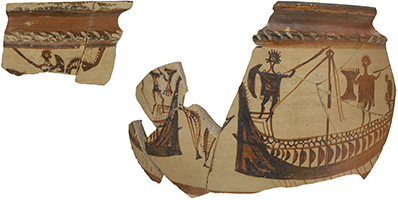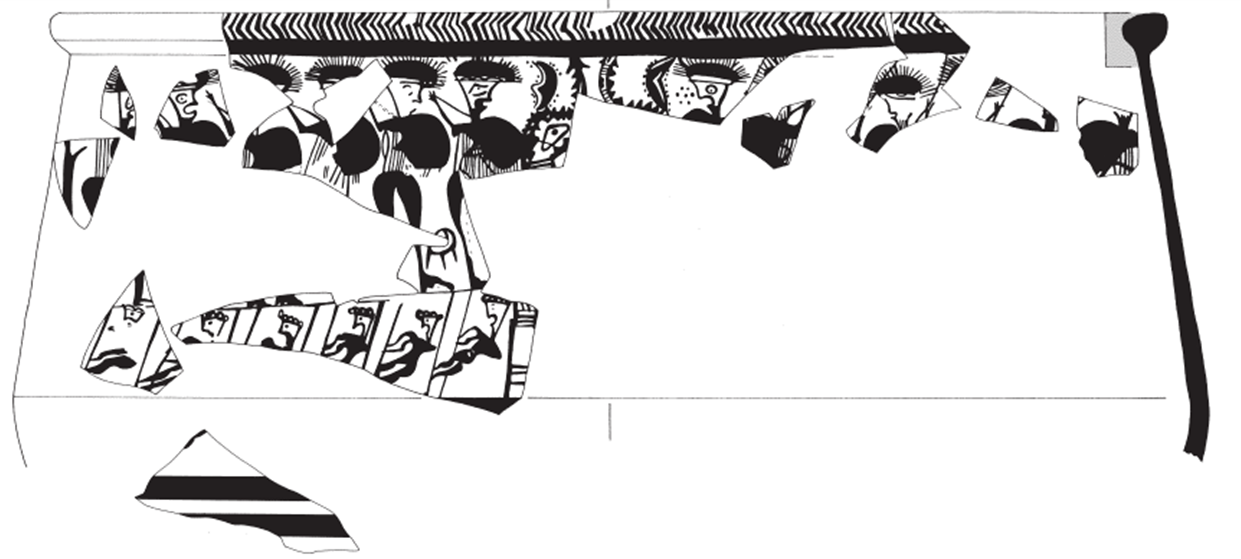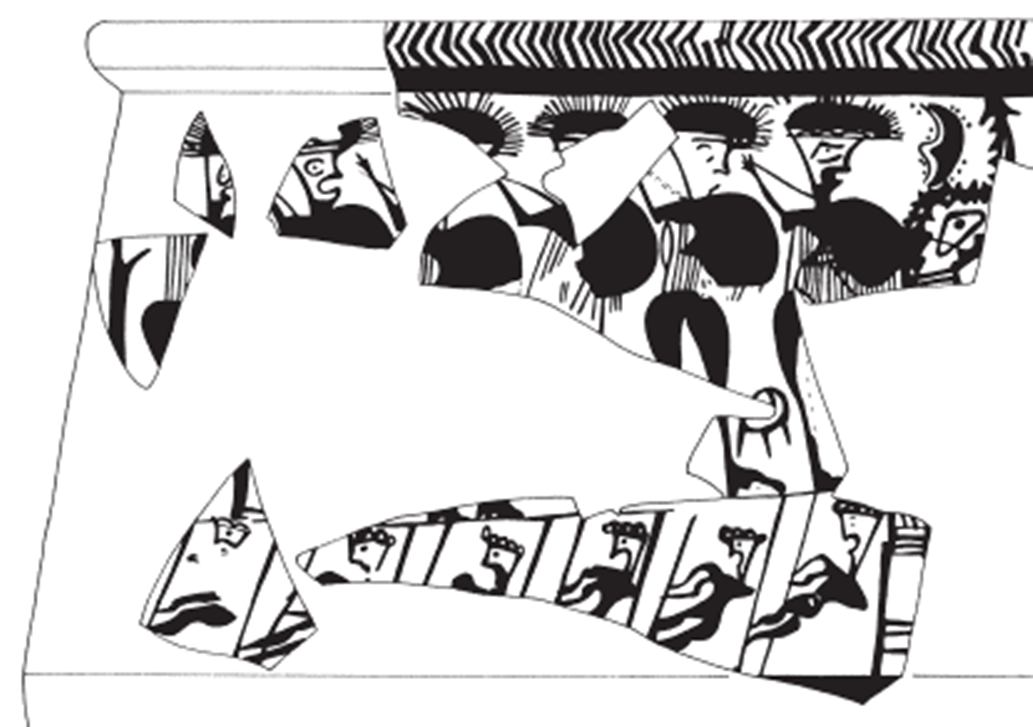The ships are painted without a mast in the center in a similar fashion to some of the Kynos ships in order to accommodate the warriors. The fact that the warriors on the left ship stand above the oarsmen indicates the presence of at least a partial deck. According to Wachsmann, "the horizontal baseline on which the warriors stand must represent a midline deck on beams slotted into wales supported by the stanchions. A screen is not in evidence. Horizontal bands cross the ship's stempost, which terminates in a forward-facing, zoomorphic device." The area of the forecastle is missing, while two sherds carry parts of what is likely to be sternposts. The sternpost on the left ship stands upright and is bifurcated at the top (sherd farthest left). It has an almost exact parallel from one of the Kynos galleys. The second sternpost resembles one on the Khaniale Tekke galleys. According to Mountjoy: "It is still unclear whether the edge of a band at the base of the left Bademgedigi Tepe ship is the top belly band that also represents the hull of the ship, or whether the band is the hull of the ship and the belly bands were below it, as on the Kynos ship. If the latter is the case, a sherd with belly bands has to be set farther down the vase; that this sherd seems to have the back of the thigh and calf of a rower preserved on the top left edge suggests the top belly band is indeed the hull. The stanchion is missing behind the body of this rower, suggesting the rower represented may be the first one in front of the stem post. The sherd would belong to a similar ship on the reverse of the vase."(Mountjoy 2011: 487). The ship's rigging is not visible. Two vertical lines linked by crossbars, with the edge of another motif at the break on the lower part. The hybrid monster figurehead has a large triangular eye with a central dot, long recurved beak with a line of solidly painted small triangles on its upper side. Beak capped by a solid triangle, with more similar triangles framing the inside of the head. Zoomorphic figurehead on opposing ship (only recurved beak extant) has similar fringe of solid triangles on the upper side of the beak. In contrast, the beak is filled with groups of crossbars similar to those on the extant stem post. Lunar-shaped motif on top of each head, behind the recurved beak. It is solidly painted with a fringe of dots (Mountjoy 2011: 484-485). Yasur-Landau compares it to the protrusion at the back of the Skyros figurehead, and argues that it does not appear to be part of a normal avian anatomy but may in fact be an ear (Yasur-Landau 2010a: 401).
Naval combat scene
A90
LH IIIC Early to Middle
Bademgedigi Tepe, west Anatolia
64 cm rim diameter
Very large krater. Deep buff-pink clay and thin white-cream slop. Locally made based on NAA
Aykurt and Erkanal 2017: 65, fig. 6; Emanuel 2014; Knapp 2019: 162-163, fig. 49; Meriç and Mountjoy 2002: 92; Mountjoy 2005; 2007: 226, 242, fig. 14; 2011; 2015: 67, 74-75, figs. 25-26; Vlachopoulos 2018: 562-563, fig. 12; Yasur-Landau 2010a: 401
Site: The site has been identified as Hittite Puranda (Hawkins 2006: 115). It is located in central West Anatolia in the plain of Torbalo. This fortified settlement with three successive fortification walls is a hilltop on the slopes of Mt. Gallesion. Its strategic significance lies in its command of nearly all directions, including the valley of Cayster as well as the roads to Ephesus, Smyrna, the Karabel pass, Colophon, Lebedus, and Clarus. Level III (1375-1300) of the settlement was especially prosperous, ending in a destruction by fire which has been attributed to warlike aggression and more specifically to the siege of Puranda by Mursili II. After this fire, the site was deserted ca. 1300 and remained unoccupied until 1180/70 BC. In describing the material culture of the newcomers (Level II), Meriç and Ãz argue that "All securely datable LHIIIC pottery, HBW, cooking pot types, and textile utensils determine to speak of a migrating community who settled down at BGK over the debris initiated by Mursili II. They were "Sea Peoples.""(Meriç and Öz 2015: 596. Also Yasur-Landau 2010b: 132-4, figs. 5.28, 33.)
Krater: A very fragmentary krater composed of sherds retrieved from the fill washed down from the acropolis, found in trenches more than 25 m in from of the fortification wall. Although the krater is very large, the painting is almost miniature, with the figures closely stacked together. Two antithetical ships face each other locked in combat, separated by a distance of only 1 cm. A line of warriors stands on deck on each ship, equipped with round shields, raised spears, fringed garments, and the characteristic feathered helmets of the Sea Peoples. A line of rowers visible on the left ship, below the warriors. Each warrior has a corresponding oarsman below in an aligned fashion. Left ship faces right, showing six warriors facing in the same direction, with six preserved rowers manning oars on a level below deck. The rowers have an identical silhouette, their back turned to the bow, with their back straining backwards and both hands on the oars. It is rare for the rowers below deck to be depicted in such detail, as they are normally either not shown at all (Tragana vase) or are drawn only as silhouettes (Kynos vase). The right ship faces left, with only 4 warriors visible. There were thus probably six, possibly seven warriors on each boat unless some of the sherds belong to a separate scene on the reverse of the vase.
To date this is the clearest two-dimensional depiction of rowers below deck level, operating their oars from an open rower's gallery intersected with vertical stanchions. The representation may connect the Kynos and Enkomi depictions with that from Skyros. The line of warriors echoes the row of warriors on the later Warrior Vase from Mycenae, and may belong to a genre that was sustained over two to three generations.
Aykurt, A. and H. Erkanal. 2017. “A Late Bronze Age Ship from Liman Tepe with Reference to the Late Bronze Age Ships from Izmir/Bademgediği Tepesi and Kos/Seraglio,” OJA 36.1: 61-70.
Emanuel, J.P. 2014. “Sea Peoples, Egypt, and the Aegean: Transference of Maritime Technology in the Late Bronze Age-Early Iron Transition (LH IIIB-C),” Aegean Studies 1.1: 21-56.
Knapp, A. B. 2018. Seafaring and Seafarers in the Bronze Age Eastern Mediterranean. Leiden: Sidestone Press.
Meriç, R. and P.A. Mountjoy. 2002: “Mycenaean Pottery from Bademgediği Tepe (Puranda) in Ionia: A Preliminary Report,” Istanbuler Mitteilungen 52: 79–98.
Mountjoy, P.A. 2005. “Mycenaean Connections with the Near East in LH IIIC: Ships and Sea Peoples,” in R. Laffineur and E. Greco (eds.) Emporia: Aegeans in the Central and Eastern Mediterranean: Proceedings of the 10th International Aegean Conference. Athens, Italian School of Archaeology, 14–18 April 2004, (Aegaeum 25). Liège: Université de Liège, pp. 423–427.
―――. 2007. “A Definition of LH IIIC Middle,” in S. Deger-Jalkotzy and M. Zavadil (eds.) LH IIIC Chronology and Synchronisms II: LH IIIC Middle. Proceedings of the International Workshop held at the Austrian Academy of Sciences at Vienna, October 29th and 30th, 2004. Vienna: Austrian Academy of Sciences, pp. 221-242.
―――. 2011. “A Bronze Age Ship from Ashkelon with Particular Reference to the Bronze Age Ship from Bademgediği Tepe,” AJA 115.3: 483-488.
―――. 2015. “The East Aegean-West Anatolian Interface in the 12th Century BC: Some Aspects Arising from the Mycenean Pottery,” in N.Chr. Stampolidis, Ç. Maner and K. Kopanias (eds.) Nostoi. Indigenous Culture, Migration and Integration in the Aegean Islands and Western Anatolia during the Late Bronze and Early Iron Age. Koç University Press 58. Istanbul: Koç University Press, pp. 37-80.
Vlachopoulos, A.G. 2018. From “Koine” to “Void”? The Art of Paintbrushes in Postpalatial Greece and their Social Implications,” In In A.G. Vlachopoulos (ed.) Paintbrushes. Wall-Painting and Case-Painting of the Second Millennium BC in Dialogue. Athens: Hellenic Ministry of Culture and Sports, pp. 557-567.
Yasur-Landau A. 2010a: On Birds and Dragons: A Note on the Sea Peoples and Mycenaean Ships, in: Y. Cohen, A. Gilan, and J.L. Miller (ed.) Pax Hethitica: Studies on the Hittites and Their Neighbours in Honor of Itamar Singer, Wiesbaden, pp. 399–410.







